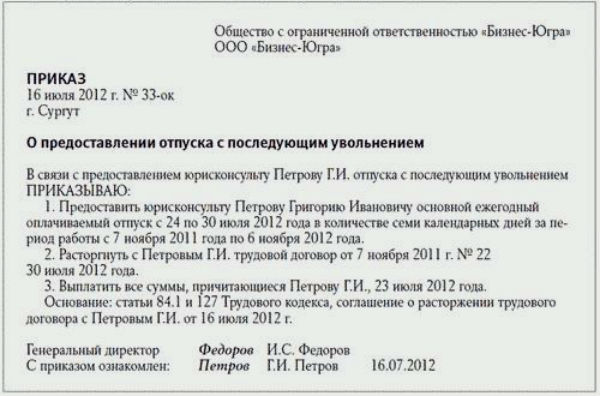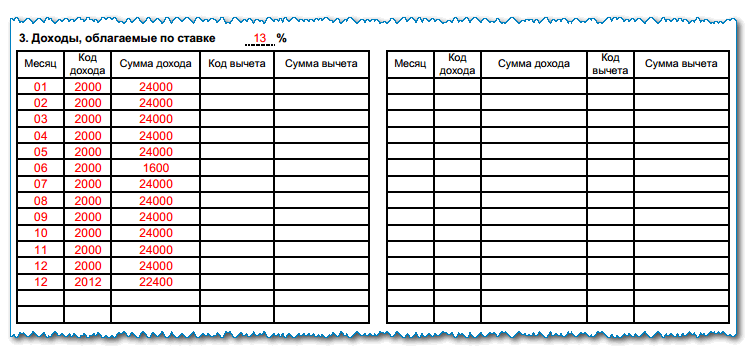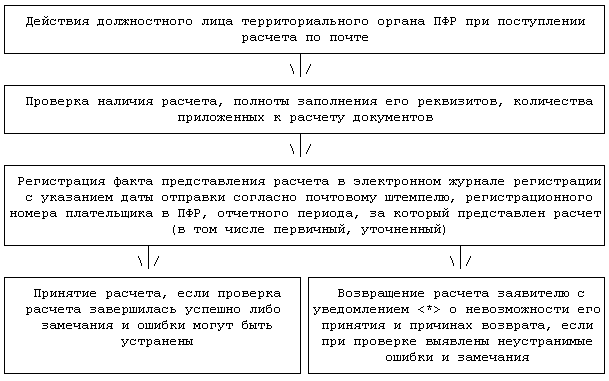Vacation followed by dismissal how to properly arrange
Upon dismissal of an employee, the law provides for a two-week period for filing an application. The performance of official duties during this period is reduced to a formal transfer of affairs.
At the same time, this situation hinders the search for a new job, the preparation of documents in a new place, leads to an unhealthy psychological climate in the team: idle curiosity, ambiguous hints, negative assessments. To avoid this, upon dismissal, you can use the employee's right to paid leave.
Relax before leaving
Vacation followed by dismissal is possible if the employee terminates the employment relationship on his own initiative or by agreement with the employer. If the dismissal of the employee occurred on the grounds caused by his guilty actions provided for by law, it is not allowed to take a vacation.
It should be remembered that the legislation leaves it at the discretion of the employer to satisfy the employee's right to leave upon dismissal.
The employee must formalize his desire for vacation in writing. Upon written application, he can be granted both an extraordinary vacation and all previously unused vacation. The basis for dismissal may be the employee's own initiative, transfer to another employer, mutual consent of the parties.
If the dismissal of an employee takes place by mutual agreement, then the whole procedure is governed by the agreement. In this case, the vacation application is written separately. In all other cases, the granting of leave can be combined with the dismissal procedure.
Vacation registration with subsequent dismissal

The employee submits two applications: for dismissal, indicating the date and reason for the termination of labor relations, and for the provision of extraordinary leave with an indication of the date, terms in calendar days. This vacation will be a vacation followed by dismissal.
Moreover, the employee in this case is not obliged to adhere to the vacation schedule, and the number of vacation days may not correspond to the next annual vacation.
In this case, the amount of leave may be equal to all previously unused vacations.
In the case of an application for termination of employment, an agreement is drawn up on such termination and only after that the employee applies for a vacation. If the dismissal of an employee is carried out for other reasons, then instead of an agreement, the employee is provided with a notification (for example, change of ownership, reduction). After the employee agrees to his dismissal by signing the notice, he draws up a vacation application.
As for the further stages of the procedure, they are absolutely identical, regardless of the basis on which the employee is dismissed.
Stages of the procedure for dismissing an employee with subsequent vacation:
- Receipt of a corresponding statement from the employee.
- After the application is signed, the employee is notified in writing against signature of the start time of the vacation.
- A corresponding order is issued.
- The document is registered in the journal.
- The employee is introduced to the document against signature.
- A settlement note is drawn up.
- The employer signs the order to dismiss the employee.
- The order is registered in the register of documents.
- The employee gets acquainted with the dismissal document against signature.
- A settlement note is drawn up, on the basis of which the settlement with the employee is carried out.
- Payments to the employee.
- A corresponding entry is made in the work book and at the same time in the account card.
- Issuance of a work book to a dismissed employee.
- Issuance of income certificates.
Statements
The vacation application is submitted simultaneously with the dismissal application and is drawn up in any form. In the vacation application, you must specify the dates and dates, as well as the number of calendar days.
But it is best to submit one application of this pattern:

The application must include the grounds for termination of the employment relationship, as well as the date of dismissal. The document is signed by the employee with his own hand, and it must be dated. After that, it is transferred to an employee of the personnel service.
Make sure they are registered in the incoming log with the date stamped.
This may be necessary if the decision to meet the employee's requirements will take a long time.
If a two-week period has passed since the registration of the applications, then the employee's requirements must be satisfied automatically. Provided that the dismissal procedure has not already been started in relation to this employee due to circumstances related to theft, negligence of the owner's property or other culpable grounds.
The application is subject to the resolution of the immediate head of the structural unit of the employee and the head of the organization. As a rule, the resolution of the head of the department is affixed before the registration of applications, after which they are submitted to the head. If the resolution is positive, the execution of orders begins. If the resolution is negative, the employee reserves the right to receive compensation for previously unused vacations.
How to determine the dates correctly?

It is generally accepted and enshrined in law that the date of dismissal of an employee falls on the last day of vacation, and the date of actual termination of the employee's duties is the day before the first day of vacation.
When calculating vacation dates, it is important to pay attention not only to the time, dates and dates directly regulated by law, but also to the date of preparation of documents, their acceptance and registration in the relevant registration logs, and also to take into account the dates falling on holidays and weekends.
All this can help both in the pre-trial settlement of disputes and during the trial. Such cases very often occur when the parties disagree on the amount and terms of payment.
Keep a record of the timeline for accepting your applications and the date on which the corresponding entries are made in the journal. If a decision on the employee's application has not been made for a long time, then after the expiration of a two-week period, all the requirements set forth in it are considered subject to satisfaction. This situation usually develops when an application is submitted for long holidays (New Year, combined May holidays), and the manager takes an early pre-holiday leave. In this case, the employer refers to the date the application was made in the register.
The dates of the documents on the basis of which the employment relationship is terminated are of great importance. In the event that the dismissal of an employee is carried out on the basis of a notice, the date of the notice must be earlier than the date of the application for dismissal. Otherwise, the employee is considered to be on vacation and is not subject to dismissal, since the deadlines provided for by law cannot be met. The situation is similar in the case of an agreement on termination of employment.
Thus, when dismissing, you must pay attention to the following dates:
- acceptance of applications for leave and dismissal of a regular employee;
- registration of applications for leave and dismissal in the register;
- an employee's vacation order;
- an order to dismiss an employee;
- date of receipt of vacation pay;
- the date of final settlement upon dismissal;
- the date of termination of the employment relationship entered in the employee's work book.
At the same time, the date of registration of orders does not play a big role, since it refers to the internal documents of the enterprise and is necessary only for the accounting system and document management. But the very fact of registration of these documents is very important.
When the relationship is terminated on the employee's own initiative, the vacation order is issued simultaneously with the dismissal order. The date must be earlier than the deadline for paying vacation pay, since it is the basis for such payments. That is, the order must be issued no later than three working days before the vacation. The dismissal order can be issued later than this period, but the employee must be familiarized with its text against signature. That is, before you actually go on vacation.
The timing of the payment of vacation pay and the final settlement with the employee is regulated by law. Vacation pay is due no later than three working days before the start of the vacation. Final settlement is made on the last actual business day.
Orders
If the employee's right to leave with subsequent dismissal is satisfied, at the request of the law, two documents are issued: an order for the employee's leave and an order for dismissal. It will not be possible to combine them due to the developed standard forms and samples. However, the legislation does not prohibit the execution of these documents with the same date.
The date of registration of these two documents must not be later than the start date of the leave of the employee to be dismissed.
An order for granting an employee a vacation must comply with the T-6 or T-6a form. It indicates the type of vacation (regular, annual without maintenance), terms, date, number in calendar days, since the employee can receive compensation for part of the vacation
The dismissal order must be executed in the form of T-8 and T-8a. The document must correctly indicate the basis for dismissal - at the initiative of the employee, since the law stipulates that the dismissed employee can terminate the contract before the expiration of the dismissal period. The date must be indicated and a note is made about the dates of such a date.
The orders must contain all the details of the documents: number, date, the signature of the head. All orders must be registered in the document journal.
But it will not be a violation to issue one order, which reflects both procedures. An example of such an order:

Filling out the work book
When an employee is dismissed, all records made in it are certified by the signature of a representative of the organization, as a rule, it is a personnel worker, certified by the seal of the organization and signed by the dismissed employee. The last entry on the termination of labor relations is entered, indicating the grounds, the date is put down - the last day of the vacation, the signature of the authorized person, the seal of the organization, as well as the signature of the employee himself are put.
At the same time, the corresponding entry is entered into the employee's record card.
When to give the work book? You can issue a work book on the last day of vacation or before vacation. In this case, if the employee picks up the application for dismissal within two weeks of the subsequent vacation, the employee's dismissal entry in the work book is considered invalid. The corresponding mark is entered in the work book
Money question

When an employee is issued a vacation with subsequent dismissal, the following material issues are subject to settlement:
- the procedure for calculating vacation pay;
- calculation of the number of vacation days;
- the amount of compensation for all previously unused days;
- wage arrears for all expired periods of the employee's work at this enterprise;
- source of payment to the employee of settlement, vacation and compensation payments;
- taxation of the employee's salary for the last billing period;
- the amount and procedure for deductions from wages, if any;
- the amount of sick leave payment if during the vacation the employee has issued a sick leave.
The legislation does not contain references on the amount of such leave and the procedure for calculating vacation pay. An employee who has not worked in the organization for a year is entitled to leave in full - 28 days... Such a right arises for an employee during continuous work in the organization after 6 months.
If leave upon dismissal is provided in full, then not in all cases it will be possible to withhold funds for unworked vacation days in the final settlement.
In this case, the employer tries to provide leave for the employee actually worked in the organization of time. Based on this, the employee is entitled to 2.33 calendar days of vacation for each actually worked month. At the same time, surpluses in the amount of less than a month are rounded down, and periods of more than a half month are rounded up to the full value.
Payments and compensation

In case of leave with subsequent dismissal, the employee is subject to the amount of accrued vacation pay, wages for the last working month, wage arrears for previous periods, and monetary compensation for previously unused vacation days.
The calculation is carried out on the basis of the continuous actual hours worked.
The relevant data is indicated in the payment card, which is filled out by an employee or employee of the personnel department and submitted to the accounting department.
Payments are made based on the employee's average monthly income accrued over the past three months.
Taxation

When an employee is dismissed for calculating personal income tax, the date of actual receipt of income by the employee is the last day when income was accrued to the taxpayer. This must be taken into account if the settlement with the employee was made from funds in the cash desk of the organization.
In this case, the law retains the obligation for the employer to transfer personal income tax, accrued and deducted from the estimated amount of the dismissed employee, no later than the next day.
In case of leave upon dismissal, the employer must transfer the amount of personal income tax to the budget no later than the first day of leave of the dismissed employee.
When to calculate?

When an employee is granted leave with subsequent dismissal, vacation pay, compensation for previously unused days, if the employee did not take all leave, calculated for the last working month, as well as other payments provided for by law, are subject to payment. In the event that the employee is in, the days on sick leave are not counted, but the employee receives a refund on the sick leave.
Vacation funds are payable three calendar days before the onset of the vacation. This is the deadline.
The final calculations are made on the last day of the actual performance by the employee of his job duties, that is, on the day preceding the day of the start of the vacation.
Terms of settlement with an employee:
- payment of vacation pay - no later than 3 days before the start date of the vacation;
- payment according to the payroll - no later than the last day actually worked by the employee;
- other payments and compensations, including those related to wage arrears - until the day of dismissal, that is, until the end of the vacation;
- tax deductions (personal income tax) - in the case of an employee calculating from the organization's cash funds no later than the next day after the settlement day.
What are the advantages and disadvantages of the situation?
Vacation followed by dismissal provides an undoubted advantage to the employee.
Employee benefits
- For the period of vacation, despite the dismissal, the employee retains all the rights of an employee of the organization.
- The vacation period is included in the work experience.
- The employee retains the right to paid sick leave during the vacation period.
- The employer must close all wage arrears for the entire period of employment.
- During the vacation, the employee is free to devote himself to finding a new job.
- The employee retains the right to withdraw the application for dismissal.
- An employee can calmly rest instead of feeling discomfort from the idle curiosity of colleagues, gossip, and negative assessments.
At the same time, the granting of leave with the subsequent dismissal for the employer is fraught with serious problems: the need to find a new employee, recalculation of the funds paid and the inability to return the amounts of personal income tax transferred to the personal income tax in the event of an employee's refusal to dismiss, as well as the timing of calculating and transferring taxes to the budget. Therefore, the employee does not always succeed in exercising his right.
At the same time, an employee who applied for leave with subsequent dismissal is also placed in a strict framework. In normal cases, the law gives you a chance to change your mind and withdraw your application within 14 days. Here, the employee does not have such a right if the vacation has already begun.
- How to get TIN via the Internet - step-by-step instructions
- The title page of the work book: all the nuances and a sample of filling
- SNILS for a newborn: instructions on how to get
- Help 3 personal income tax - what is it?
- How to fill out a cash flow statement: line example
- Registration of an incoming cash order: filling out and examples
- What documents are needed to receive snills for a child
- Form AO-1. Advance report
- Rules and procedure for filling out an advance report by an accountant and accountable persons
- Help 2-NDFL sample filling
- How to fill out an application in the form of ENVD-2
- Financial analysis methods What tasks are solved using financial analysis
- Professional adaptation of employees Stages of staff adaptation
- Step-by-step classic recipe for snickers cake with photo
- Original recipe: duck fillet for housewives with imagination
- Unsweetened muffins - recipes
- Fish stew with vegetables - the best recipes for the whole family Fish with vegetables in tomato sauce
- Pickled pumpkin - unusually tasty recipes for a spicy treat Pickled pumpkin with cinnamon
- Universal yeast dough without eggs and milk
- Liver salad with Korean carrots and pickled onions Korean chicken liver salad









